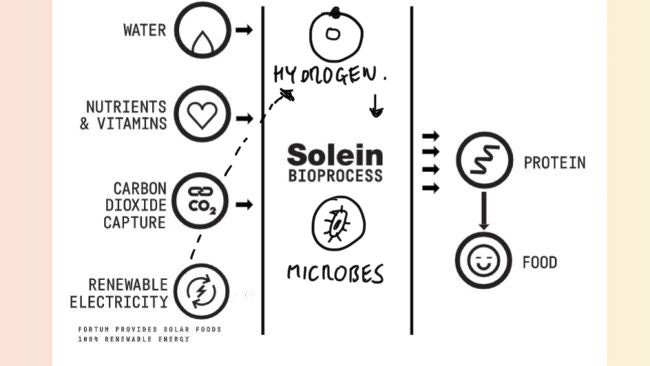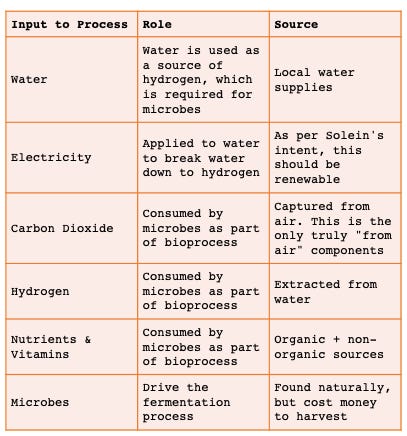Explained: What is Food from Thin Air?
The slow death of the food industry if this business model becomes reality
SO WHAT IS FOOD FROM THIN AIR IN BRIEF?
More than 50 years ago, NASA derived a process to harvest protein energy from little more than air, waste CO2, and water. The big idea: that it could sustain astronauts on long space missions. The bacteria integral to the process eat only hydrogen bubbles, carbon dioxide, nutrients and vitamins. And what is created is protein - which can be used as a source of food.
OK – SO CAN YOU TELL ME MORE?
The process below shows the process as outlined by Solein, one of the leading contemporary proponents of "from air" technology:
In the following table I have mapped out the inputs to the process, the role they play, and the source:
It is clear from the above that not the whole product is "from air", but that all input materials come from sources conventionally not related to the arable land which would normally be a factor in food production.
WHY IS THIS BUSINESS MODEL RELEVANT TO FMCG?
The reality of global food supply chains is that input materials and sources of ingredients are not always in the same location as demand. Moving food between countries has an impact on the environment, on food supply security (think about the impact that the Suez Canal blockage had on global shipping patterns), and cost (moving things across the world isn't free).
Food from thin air offers an opportunity to bring protein production to areas where conventional agriculture is a challenge due to factors such as land conditions, land availability, or climate. Even in regions where there may be significant land for farming available, "from air" protein creation allows for proteins to be grown quicker without worries about climate-driven weather or water conditions.
ARE THERE ANY SPECIFIC COMPANIES OR MARKETS WE SHOULD BE INTERESTED IN?
In his excellent book on the subject of New Agrarian practices1, Jim Mellon references two companies of particular note, Air Protein and Solar Foods (of which Solein as mentioned above is the main product.)
Based in California, Air Protein’s business model is “to sell a chicken-like protein product directly to the food service industry.” Solein’s current plan is that its product would be used as an alternative to soy or pea in plant-based meat and dairy.
From this perspective, it seems that the formative business models are not dissimilar and the key differences between the companies lies in the species of microorganisms that they use, as well as their process engineering.
WHAT ARE THE ECONOMICS OF THE BUSINESS MODEL?
The key challenges of the business model are around getting the supply-side economics correct. Let’s take again the inputs as highlighted above and map out the cost impact of each and what implication that has on business model set-up:
In his excellent book on the subject of New Agrarian practices, Jim Mellon references Solein as being able to sell at €2.20/kg in ideal production scenarios, which is comparable to the lowest-cost chicken.
Likewise Air Protein believes that its proteins will be cheaper at scale than soil or protein.
If such cost positions were reached, this would begin to offer up considerable opportunity on the demand-side.
On the demand side there are three possible uses for the product created
as a protein ingredient as any ingredient today in common food like pastas, breads and plant-based dairy (B2B)
as a plant-based meat alternative, similar to veggie burgers (B2B or B2C)
as a food source for lab-grown meat alternatives (B2B or B2C)
The key question is going to be whether it is possible to get the consistent volume and confidence in the technology to run at the "ideal production scenarios" required to be cost-competitive.
ANYTHING ELSE OF INTEREST?
This is just one business model within the broader development of cultivated and plant-based proteins. This is sure to become more significant over the next few years and will surely be written about elsewhere and in future on Consumer Goodies!
Mellon, J. (2020). Moo’s Law. Fruitful Publication





